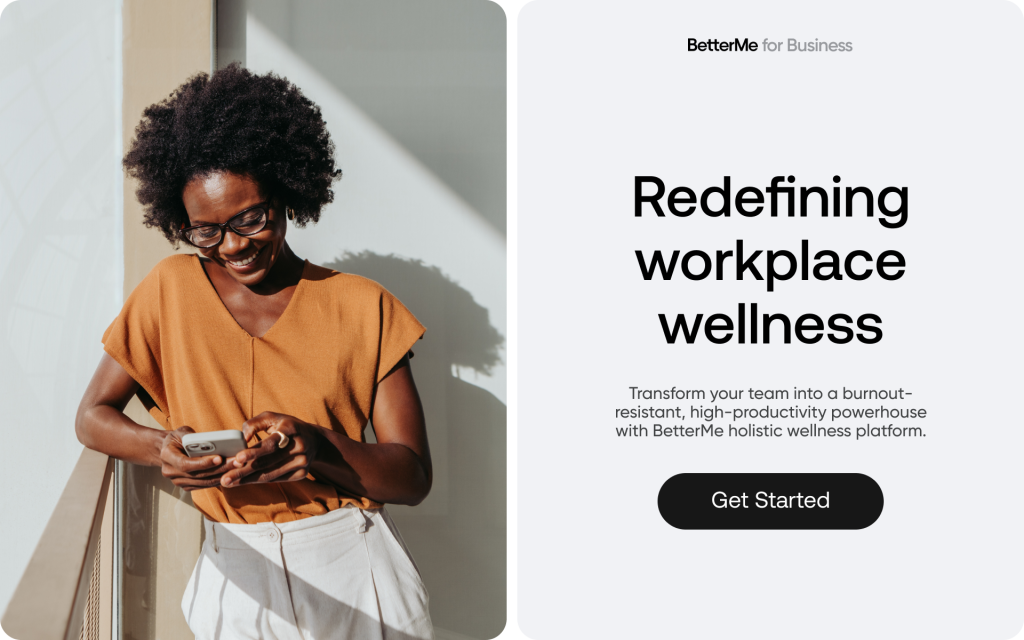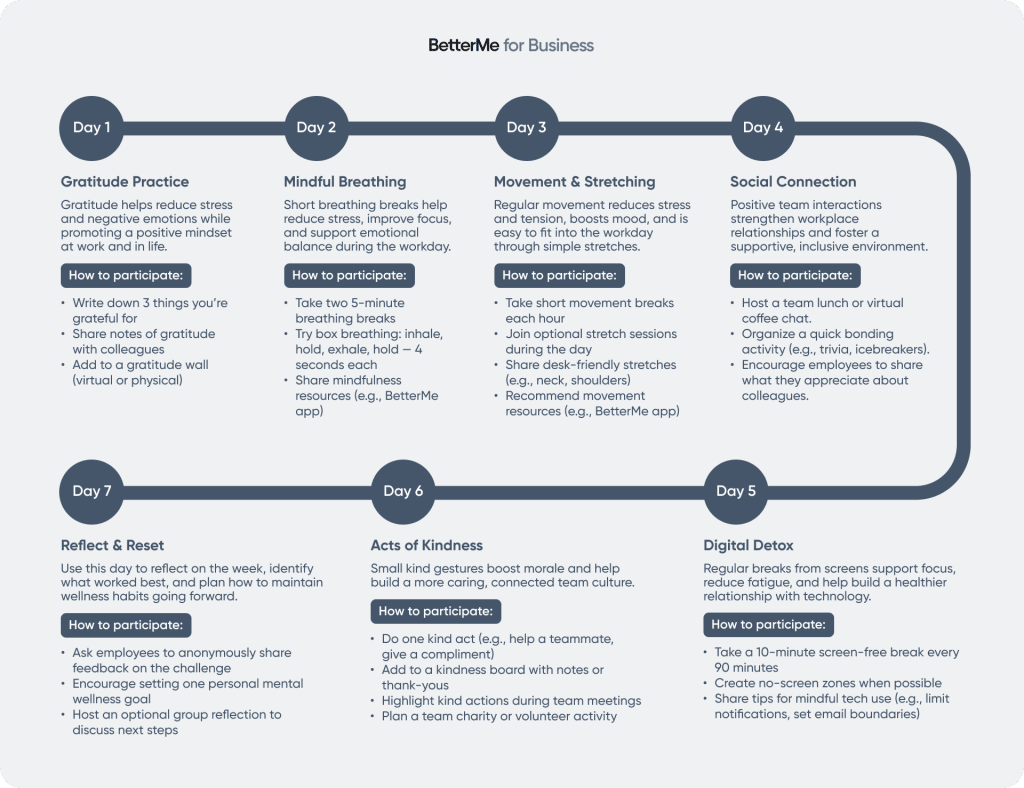Going into the office often means facing endless to-do lists, back-to-back meetings, and mounting deadlines, creating an atmosphere where stress feels like the norm.
For many workplaces, this cycle of burnout and disengagement is all too common – but what if only a few small changes could lead to big improvements? This is where mental wellness activities come into play. By integrating simple, intentional acts, such as short mindfulness breaks or team check-ins, you can build a workplace culture that prioritizes individual well-being while also enhancing team productivity, collaboration, and success.
This 7-day challenge offers a practical and engaging way to support your team’s mental wellness with small habits that make a big difference.
Why Mental Wellness Matters in the Workplace
According to a 2022 report, nearly 20% of U.S. employees rate their mental health as fair to poor, resulting in significantly more unplanned absences and costing the overall U.S. workforce an estimated $47.6 billion annually in lost productivity (1).
Mental wellness is crucial for a productive, positive workplace culture. When employees feel supported in their mental health, they are more engaged, focused, and motivated in their work (2). Conversely, neglecting mental health can lead to burnout, absenteeism, and reduced productivity – all of which can negatively impact both individuals and the organizations they work for (3).
Prioritizing your team’s mental wellness can be a beneficial first step toward boosting morale, improving productivity, and driving overall success in the workplace.
The Power of Small Daily Habits
Small, intentional habits may seem minor at first, but their cumulative impact can lead to significant long-term benefits (4). Practicing small habits daily can be an effective way to achieve your workplace goals and see meaningful results over time.
Before getting started, it’s helpful to distinguish between habit vs routine (5):
- Habits are automatic behaviors that become second nature over time, such as grabbing your keys when you leave the house.
- Routines are intentional, structured activities you incorporate into your daily life, such as taking a morning walk or a mindfulness practice.
Both habits and routines play a key role in supporting mental wellness. Some healthy habits to start out with may include stepping away from screens, taking short walks, or spending time outdoors in the middle of the workday. What matters most is choosing habits that support your team’s goals and align with your desired results (6).
With consistency, these small steps can lead to big changes, potentially contributing to a healthier and more productive workplace environment.
The Role of Team Interaction for Mental Wellness
Positive team interactions also play a critical role in promoting mental wellness in the workplace. Social support from colleagues is essential in reducing feelings of isolation and fostering a sense of belonging (7). Employees who feel connected with their coworkers are often more engaged and collaborate better as a team (8).
Encouraging interactions among group members can look different for everyone, such as informal check-ins, shared coffee breaks, or brief moments of laughter, but building a truly supportive workplace culture requires intentional communication and teamwork (9).
When employees feel trusted and supported by their peers, they’re often better able to navigate challenges and contribute to a positive, inclusive workplace atmosphere (10). As a result, this sense of support has the power to improve both individual mental health and overall workplace productivity (11).
Read more: Companies That Offer Sabbaticals: What They Have in Common
7-Day Mental Wellness Program for Employees
With an estimated 81% of employees in 2022 seeking workplaces that prioritize mental health, implementing a wellness challenge can be a great way to demonstrate your commitment to employee well-being (12). Fortunately, supporting mental wellness in the workplace doesn’t have to be all that complicated.
This 7-day mental wellness program for employees offers simple, actionable activities to improve mental well-being through simple, actionable activities that can be seamlessly integrated into the workday. For best results, encourage your team to participate and reflect on how these activities impact their overall mood and productivity (3, 13).
Toxic Work Culture? This 7-Day Challenge Could Be the Fix You Need. Book a Free Consultation to learn how we can help your company build a stress-free and positive environment.
Remember that these mental health challenge ideas and days can be adapted to suit your company’s culture and team’s needs. Once you’re ready to begin, here’s a simple 7-day mental wellness program to introduce in your workplace:
Day 1: Gratitude Practice
Practicing gratitude has been shown to improve mental health by reducing feelings of distress and other negative emotions while fostering an overall more positive outlook on life (14). For employees, it can offer a helpful shift in perspective, redirecting focus from challenges or demanding tasks to the positives in their lives and workplace.
Here’s how to participate:
- Start the day by writing down at least three things you’re grateful for.
- Share gratitude notes with colleagues to foster a positive workplace atmosphere.
- Create a gratitude wall (in person or virtually) where employees can share their positive moments, expressions of gratitude, or reflections throughout the week.
Day 2: Mindful Breathing Breaks
Mindful breaks for deep breathing are a quick and effective way to reduce stress, boost focus, and regulate emotions in a healthy way (15). Practicing them regularly can help you become more comfortable, potentially making it easier to use these techniques whenever work-related stress arises or amidst a busy, demanding workday.
Here’s how to participate:
- Schedule two 5-minute breathing breaks for the team during the workday.
- Practice box breathing, a simple breathing exercise (16): Inhale for 4 seconds, hold for 4 seconds, exhale for 4 seconds, and hold again for 4 seconds. Repeat this a few times until your mind and body feel calm, centered, and relaxed.
- Share access to other breathing and mindfulness resources for those seeking additional mental health support, such as the BetterMe app.
Day 3: Movement and Stretching
The benefits of physical movement for mental wellness are undeniable. Engaging in physical activity or exercise helps reduce both physical and emotional stress, releases feel-good endorphins, and alleviates tension (17). Stretching may be particularly useful in the workplace as it’s a low-impact activity that requires no equipment, making it easy to do anywhere at any time whenever you feel tense or stressed out (18, 19).
Here’s how to participate:
- Encourage employees to take short movement breaks every hour (e.g., standing up, walking around, stretching).
- Schedule optional stretch breaks throughout the workday, allowing employees to join whenever they feel the need.
- Share easy, desk-friendly stretches that target common tension areas, such as shoulder rolls, neck stretches, or seated twists.
- Provide access to other resources that teach employees how to stay more active and remain mindful in their movement, such as the BetterMe app.
Day 4: Social Connection
Building meaningful connections with colleagues is essential for promoting a positive, supportive workplace culture (7, 10, 11). By encouraging constructive, meaningful team interactions, you can begin strengthening workplace relationships while contributing to a more inclusive atmosphere where everyone feels valued, respected, and appreciated.
Here’s how to participate:
- Host a team lunch or coffee break (in person or virtually) where employees can chat together and connect informally.
- Organize a fun and quick bonding activity to help your team connect on a deeper level, such as trivia games or icebreaker questions.
- Get everyone involved by asking team members to share things they appreciate or admire about their colleagues to promote positivity.
Your Competitors Are Already Investing in Team Well-Being—Why Aren’t You? Book a Free Consultation to learn how we can help your company build a stress-free and positive environment.
Day 5: Digital Detox Moments
Many jobs require prolonged screen time, which can decrease mental and physical well-being. lead to fatigue and mental burnout (20) – so it’s essential to schedule regular screen breaks. Taking intentional moments away from digital devices can help employees better recharge, refocus, and develop a healthier relationship with technology, enabling them to be their most productive selves.
Here’s how to participate:
- Encourage employees to take a 10-minute screen-free break every 90 minutes.
- Create “no-screen zones” in common areas or during meetings when feasible.
- Share mindful tech usage tips, such as turning off unnecessary notifications or setting boundaries around email after work hours.
Your Team Deserves a Positive, Stress-Free Workplace—Here’s How to Create One. Book a Free Consultation to learn how we can help your company build a stress-free and positive environment.
Day 6: Acts of Kindness
Acts of kindness not only uplift individuals but also contribute to a supportive workplace culture that prioritizes strengthening team bonds (21). Even the smallest gestures can create powerful ripple effects that boost your overall team morale.
Here’s how to participate:
- Challenge employees to perform one act of kindness today, such as offering help with a task or giving a compliment.
- Set up a kindness board where team members can acknowledge each other’s positive actions and leave thank-you notes.
- Recognize acts of kindness publicly during team meetings or in newsletters to inspire others to participate.
- Discuss organizing a group initiative outside the office, such as donating to a local charity or volunteering together in your community.
Day 7: Reflect and Reset
The final day of the challenge is an excellent opportunity to regroup and reflect on which activities were most and least beneficial (13). This helps process individual experiences, identify areas for growth, and set intentions for maintaining mental wellness beyond the challenge moving forward.
Since each workplace culture is highly unique, not every activity may resonate with all employees. Use this day to gather feedback and tailor future routines to better suit your team’s needs, ensuring ongoing progress and success.
Here’s how to participate:
- Ask employees to anonymously reflect on the past week with optional prompts:
- Which activities were most and least beneficial for you this week?
- How do you feel now compared to the start of the challenge?
- How did this challenge impact your relationships with colleagues?
- What changes did you notice in your stress levels, focus, and productivity?
- Were there any activities you found surprisingly helpful or challenging?
- Encourage everyone to set at least one personal goal for incorporating mental wellness habits into daily life moving forward.
- Host an optional group reflection session where team members can collaborate and share insights on how to continue these practices in the workplace.
Read more: How to Keep Employees Engaged: Here’s What Great Managers Do
How This 7-Day Challenge Can Improve Team Culture and Engagement
Participating in mental wellness activities at work can provide significant benefits for individual well-being and workplace culture. By incorporating some of these daily habits to improve life, you can begin cultivating stronger connections, improving collaboration, and creating an overall more productive work environment.
In a nutshell, some lasting benefits of promoting mental wellness at work include (10, 22):
- Stronger connections through more meaningful team interactions
- Boosted team morale with acts of kindness, gratitude, and mindfulness
- Increased engagement at work with greater focus, productivity, and motivation
- Positive, supportive environment where everyone feels valued and appreciated
While this 7-day challenge is a great starting point, maintaining momentum is key. The habits and actions taken throughout the week can serve as the foundation for long-term well-being for everyone in the workplace. Remember, small steps lead to big changes.
The Bottom Line
From boosting morale and productivity to building stronger team connections, these mental wellness activities are great ways to cultivate a more positive workplace culture.
While this challenge only lasted seven days, maintaining the habits that work best for you and your team can lead to lasting benefits. Use feedback and insights from your workplace’s needs to continue incorporating these practices into your routines.
For more challenges and resources, be sure to check out the BetterMe app – your go-to destination for tips, tutorials, and support on your journey to a healthier, happier you.
DISCLAIMER:
This article is intended for general informational purposes only and does not serve to address individual circumstances. It is not a substitute for professional advice or help and should not be relied on for making any kind of decision-making. Any action taken as a direct or indirect result of the information in this article is entirely at your own risk and is your sole responsibility.
BetterMe, its content staff, and its medical advisors accept no responsibility for inaccuracies, errors, misstatements, inconsistencies, or omissions and specifically disclaim any liability, loss or risk, personal, professional or otherwise, which may be incurred as a consequence, directly or indirectly, of the use and/or application of any content.
You should always seek the advice of your physician or other qualified health provider with any questions you may have regarding a medical condition or your specific situation. Never disregard professional medical advice or delay seeking it because of BetterMe content. If you suspect or think you may have a medical emergency, call your doctor.
SOURCES:
- The Economic Cost of Poor Employee Mental Health (2022, gallup.com)
- Relationship between Employee Mental Health and Job Performance: Mediation Role of Innovative Behavior and Work Engagement (2022, nih.gov)
- The Role of Mental Health on Workplace Productivity: A Critical Review of the Literature (2022, nih.gov)
- Making health habitual: the psychology of ‘habit-formation’ and general practice (2012, nih.gov)
- The Importance of Creating Habits and Routine (2018, nih.gov)
- Goal Setting and Action Planning for Health Behavior Change (2017, nih.gov)
- Social support and mental health: the mediating role of perceived stress (2024, frontiersin.org)
- The Importance of Social Connections in the Workplace (2025, WebMD Heath Services)
- The Contribution of Communication to Employee Satisfaction in Service Firms: A Causal Configurational Analysis (2022, journals.sagepub.com)
- Impact of Employees’ Workplace Environment on Employees’ Performance: A Multi-Mediation Model (2022, nih.gov)
- Fostering belonging and social connectedness in nursing: Evidence-based strategies: A discussion paper for nurse students, faculty, leaders, and clinical nurses (2024, sciencedirect.com)
- Workers appreciate and seek mental health support in the workplace (2022, apa.org)
- Reflection: The Pause That Brings Peace and Productivity (2022, library.hbs.edu)
- The effects of gratitude interventions: a systematic review and meta-analysis (2023, nih.gov)
- Effect of Mindfulness Breathing Meditation on Depression, Anxiety, and Stress: A Randomized Controlled Trial among University Students (2022, nih.gov)
- Take a Deep Breath (2023, nih.gov)
- The impact of exercise on depression: how moving makes your brain and body feel better (2024, nih.gov)
- The Effects of Active Stretching Exercise on Mood and Autonomic Modulation in Middle-Aged Women (2024, liebertpub.com)
- The simple act of stretching (2021, research.colostate.edu)
- The hazards of excessive screen time: Impacts on physical health, mental health, and overall well-being (2023, nih.gov)
- Acts Of Kindness Have Become A Workplace Standard, According To Groundbreaking Research (2023, forbes.com)
- The Value of Worker Well-Being (2019, nih.gov)











